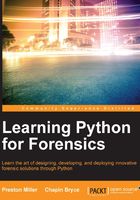
Summary
This chapter has covered a wide range of introductory content that provides a foundation to be built upon throughout the duration of this book; by the end you will become well-versed in Python development. These topics have been handpicked as the most important items to comprise a basic understanding of the language as we move forward. We have covered data types, what they are and when they are used, variable naming and the associated rules and guidelines, logic and operations to manipulate and make decisions based on values, and conditions and loops that provide a sequential organization for our scripts form the baseline of everything we develop.
Through these features alone we can create basic scripts. Python is a very powerful and complex language belying its simplistic syntax. At this point, you should feel comfortable with the Python interpreter if you have been re-typing the prompts (>>>) as presented in the code blocks. In the next chapter, we will explore more complex foundational items and continue expanding upon the knowledge established in this chapter prior to moving into real world examples.